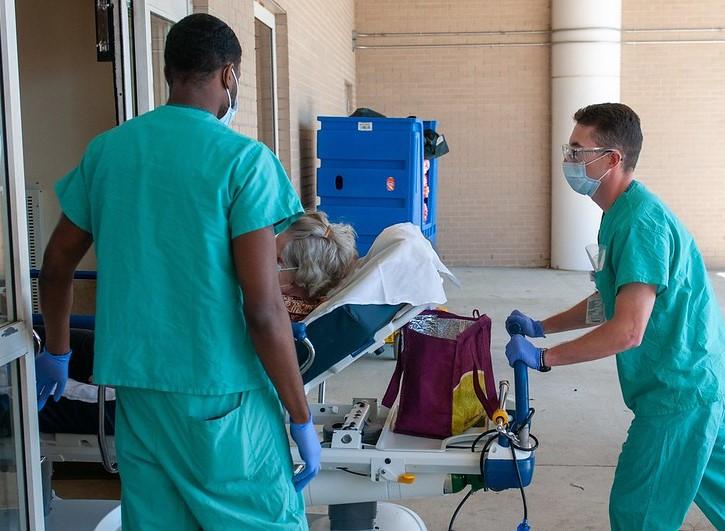COVID-19 case surges at the most overwhelmed US hospitals in spring and summer 2020 may have contributed to nearly one in four adult inpatient deaths, according to a study yesterday in the Annals of Internal Medicine.
Led by researchers from the National Institutes of Health Clinical Center, the study involved patient- and hospital-level analyses of the Premier Healthcare Database, creation of a weighted COVID-19 caseload-to-bed capacity surge index, and hierarchical modeling. The authors calculated risk-adjusted odds ratios (aORs) for death from Mar 1 to Aug 31, 2020, or release to hospice at 558 hospitals through Oct 31.
High-burdened hospitals had twice the risk of death
Among 144,116 coronavirus inpatients 18 years and older, 78,144 (54.2%) were admitted to hospitals in the top surge index decile. Of all inpatients, 35,883 (24.9%) were admitted to an intensive care unit (ICU), 19,583 (13.6%) required mechanical ventilation, and 25,344 (17.6%) died, with decreasing death rates over time at all surge index levels.
Hospital overcrowding may have contributed to 5,868 (23.2%) of COVID-19 hospital deaths.
Compared with hospitals without surges (less than the 50th surge index percentile), the aOR for COVID-19 death in the 50th to 75th percentile was 1.11, while it was 1.24 for the 75th to 90th percentile, 1.42 for the 90th to 95th percentile, 1.59 for the 95th to 99th percentile, and 2.00 in the top percentile. The association did not differ by hospital ward, ICU, or intubation status.
The association between surge index level and death was more robust in June to August than in March to May, despite more corticosteroid use and more selective use of intubation in the summer COVID-19 surges.
Groups of hospitals with very high coronavirus surge indices were seen in the Northeast in April and in the South and West in July. In non-peak COVID-19 months, 11,041 (7.7%) of coronavirus patients were admitted to 378 (67.7%) hospitals, compared with 78,144 (54.2%) admitted to hospitals in the top index decile experiencing surges and 27,606 (19.2%) in the 99th percentile.
From March to May, 49 hospitals entered the surge index 99th percentile, and 20 hospitals joined this category from June to August. Within this category from March to May, Hispanic patients made up 18% of COVID-19 cases and 16% of deaths, increasing to 65% of cases and 71% of deaths from June to August. Non-coronavirus caseload differences did not appear to change the association between surge index level and death rate.
Better preparation, support needed
From March to May, 10% of patients in hospitals not seeing onslaughts and 4.3% in those in the surge index 99th percentile and above required intubation at admission, fluctuating from 3.2% to 4.3% from June to August. Admissions from March to May had a higher frequency of age-stratified do-not-resuscitate orders than in the later months.
Median patient age from March to May was 64 years, dropping to 61 years from June to August. Over the study period, other demographic factors and rates of underlying illnesses remained similar.
The authors noted that, while studies have found that more effective medications and better supportive care improved COVID-19 survival as the pandemic unfolded, many US hospitals struggled with caring for patients with limited staff capacity, space, and supplies such as respiratory support devices and personal protective equipment.
To mitigate surges, the researchers recommended prioritizing staff, supplies, and logical support as soon as possible when faced with an epidemic, especially in hospitals with anticipated case surges.
"Despite improvements in COVID-19 survival between March and August 2020, surges in hospital COVID-19 caseload remained detrimental to survival and potentially eroded benefits gained from emerging treatments," they wrote. "Bolstering preventive measures and supporting surging hospitals will save many lives."
Taking a coordinated, regional approach
In an editorial in the same journal, Vineet Chopra, MD, of the University of Michigan at Ann Arbor, said system-level changes to hospital operations have substantial consequences for clinicians, who are tasked with managing a little-known virus in unfamiliar areas of the hospital with different staff and new decision-making protocols.
To prevent future surge-related deaths, Chopra suggests understanding that COVID-19 surges affect many hospitals. "Therefore, the current approach, which largely consists of 'every hospital for itself,' must be changed," he said. "Instead, we need a coordinated, regional approach to absorb the shock of rapid increases in COVID-19 volume."
Chopra said it's also important to consider the effects of COVID-19 surges on healthcare workers, many of whom have said they are considering leaving their profession because of burnout.
"It is all but certain that future surges, if managed using our current paradigm, will not only harm patients but also weaken the strength and resolve of our most precious resource: our people," he said.





















